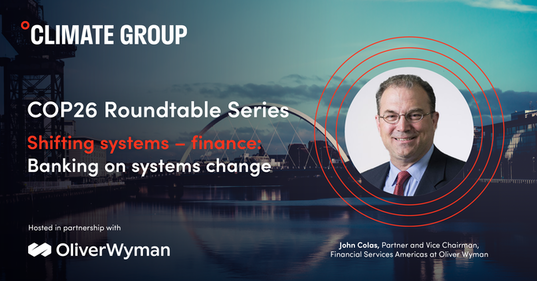We were pleased to speak to John Colas, Partner and Vice-Chairman, Financial Services Americas at Oliver Wyman, to discuss his main takeaways from COP26 and the implications for financial services moving forward.
John has worked in each of the world’s principal financial centers advising senior management in financial services and the public sector on critical matters of strategy, regulation, and risk and capital management. He is a co-leader of Oliver Wyman’s Climate and Sustainability platform while also serving on Marsh & McLennan’s Climate Risk and Sustainability Task Force and Environmental, Social, and Corporate Governance Committee.
1. What are some of your main takeaways from COP26 – particularly Finance Day?
COP26 gave us many reasons for optimism and hope: the mobilization of financial institutions to net zero, the global pledge to reduce methane emissions, commitment from 26 countries to phasing out coal power, and action to halt and reverse forest loss and land degradation. There was also a substantial increase in the explicit commitments to financing clean energy transitions in emerging and developing economies. And, of course, the IFRS’s announcement of the formation of a new International Sustainability Standards Boards (ISSB).
This was the first COP that had a Finance Day and there was a lot of value in drawing in the financial sector. A pivotal moment was the commitment by the Glasgow Financial Alliance for Net Zero – responsible for more than $130 trillion in financial assets – to align their operations and financing with achieving 1.5C. The UK Chancellor’s announcement of the UK’s intention to become the world’s first net zero aligned financial centre, with a new requirement for mandatory net zero transition plans for UK financial institutions and companies was also very significant.
This emphasis on transition plans, which was foreshadowed by the guidance produced by the Task Force on Climate-Related Financial Disclosures (TCFD) in October, is a crucial development. Ultimately, we will not achieve a net zero transition without well-crafted, well executed, and credible transition plans, so focusing on transition plans is essential.
2. How will the Glasgow Financial Alliance for Net Zero’s plans be set and achieved?
The guidelines for setting the targets, and ultimately delivering against the targets, is highly prescribed by the UN’s Race to Zero. Banks that have signed up to the Net Zero Banking Alliance (NZBA) have specific guidelines and requirements to follow. These include using science-based sector pathways to set targets, publishing a net zero transition strategy, and reporting annually on progress.
These actions are happening in real time. For example, during COP26, Morgan Stanley and BBVA each announced very specific 2030 interim targets for important sectors of their portfolios, calling for meaningful reductions in their financed emissions in greenhouse gas intensive sectors.
Within each GFANZ institution there will continue to be active discussions and analysis regarding what's feasible in terms of the current portfolio, customer sets, and prevailing customer transition plans. Achieving Net Zero targets will require active discussion and dialogue with clients as well as the active monitoring and measurement of progress. Capital will be needed help companies reduce their emissions and transition their business practices to cleaner and greener operations.
Implicit in setting net zero targets is an assumption, or series of assumptions, on how public policy may evolve to further encourage and set incentives to accelerate the transition. Essentially the banks can set the targets, but it will require follow through both from the public sector in terms of policies that encourage decarbonization, as well as business strategies from corporate clients to deliver real world decarbonization. It’s safe to say this will surely be an ongoing process.
3. What are some of the biggest challenges to setting net zero targets, and how can they be overcome?
The biggest challenge is making sure that we have accurate and credible data. In addition, ensuring that that data is being continually updated and refreshed so that the metrics are transparent and trackable. I think these challenges can be overcome by continuing to work on the problem. As companies improve their own disclosures, more information will be available to the markets and to the finance community. That is the direct intent of the TCFD, to provide that transparency and the meaningful metrics so that allocators of capital can make better decisions.
4. What will it take for the remaining 60% of the financial system to follow suit in supporting the net zero transition?
Marketplace pressures are likely to emerge in terms of customers and shareholders wanting to know what company's transition plans are. Forces on the policy and regulatory side will also be key – i.e., mandatory disclosure of transition plans. The more that the regulatory frameworks align to net zero, the more corporations and financial institutions will follow suit.
5. What are your hopes for COP27?
In short, seeing tangible progress on delivering on the promise of COP26 and the Paris Agreement. I would like to see advances in the global architecture and mobilization of capital to emerging markets and developing economies to finance a just transition. Ideally, I would also like to see more policy and regulatory progress in embedding net zero best practice along with other countries following the UK in mandatory disclosure of transition plans.
Importantly, we will need to see a material upswing in transition finance towards realizing net zero- - especially the mobilization of capital for innovative breakthrough decarbonization technologies, drawing not only from banks but also venture capital, private equity, impact investors, and the public sector.
